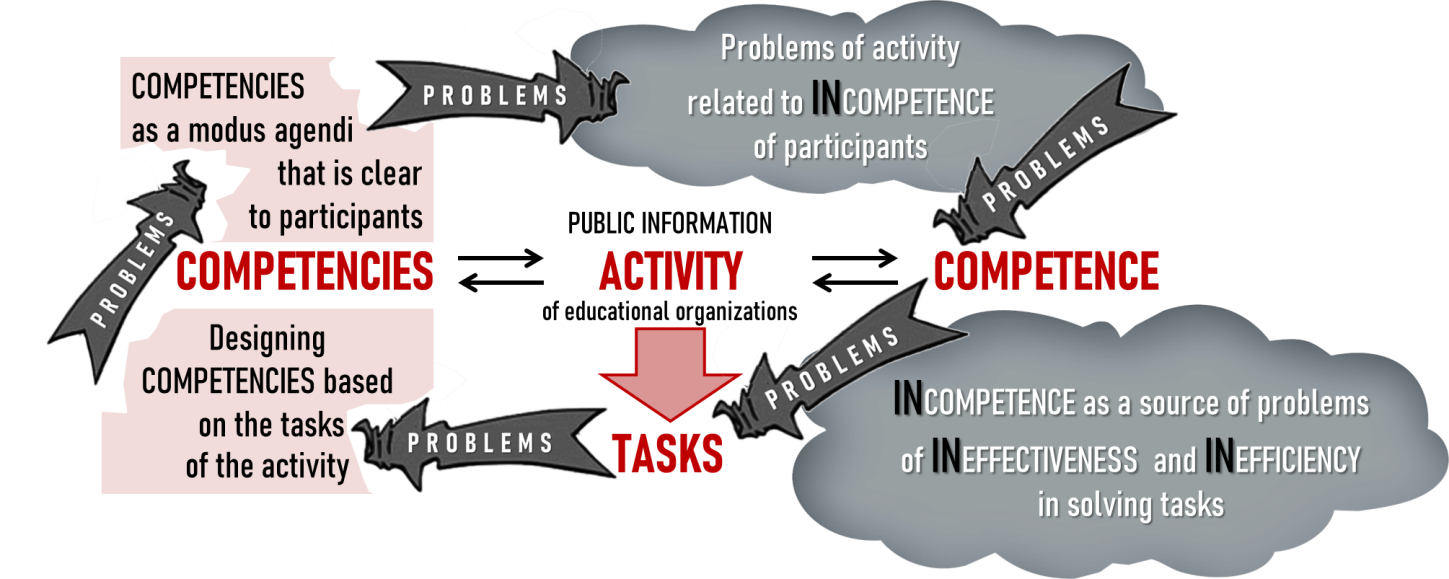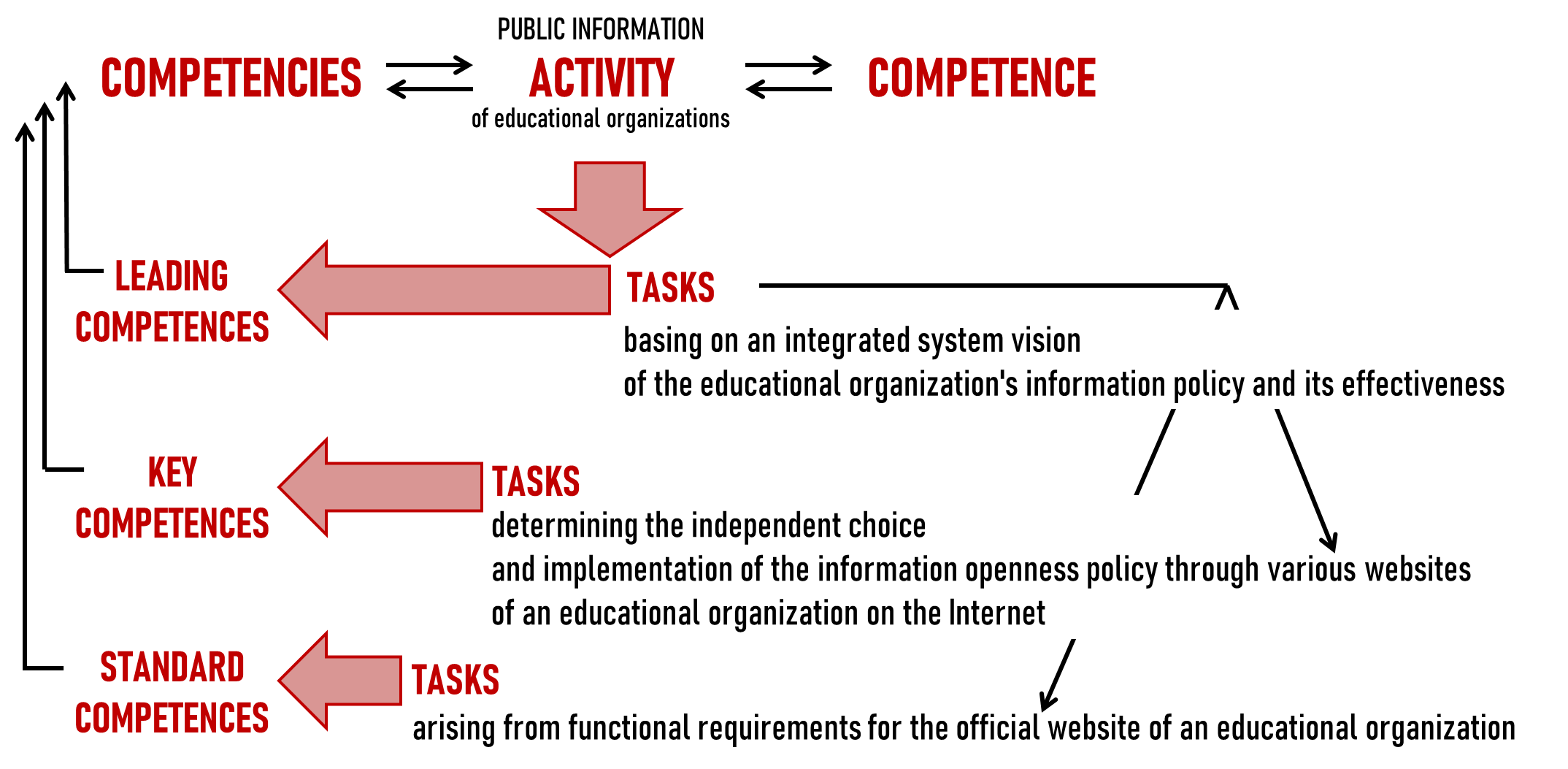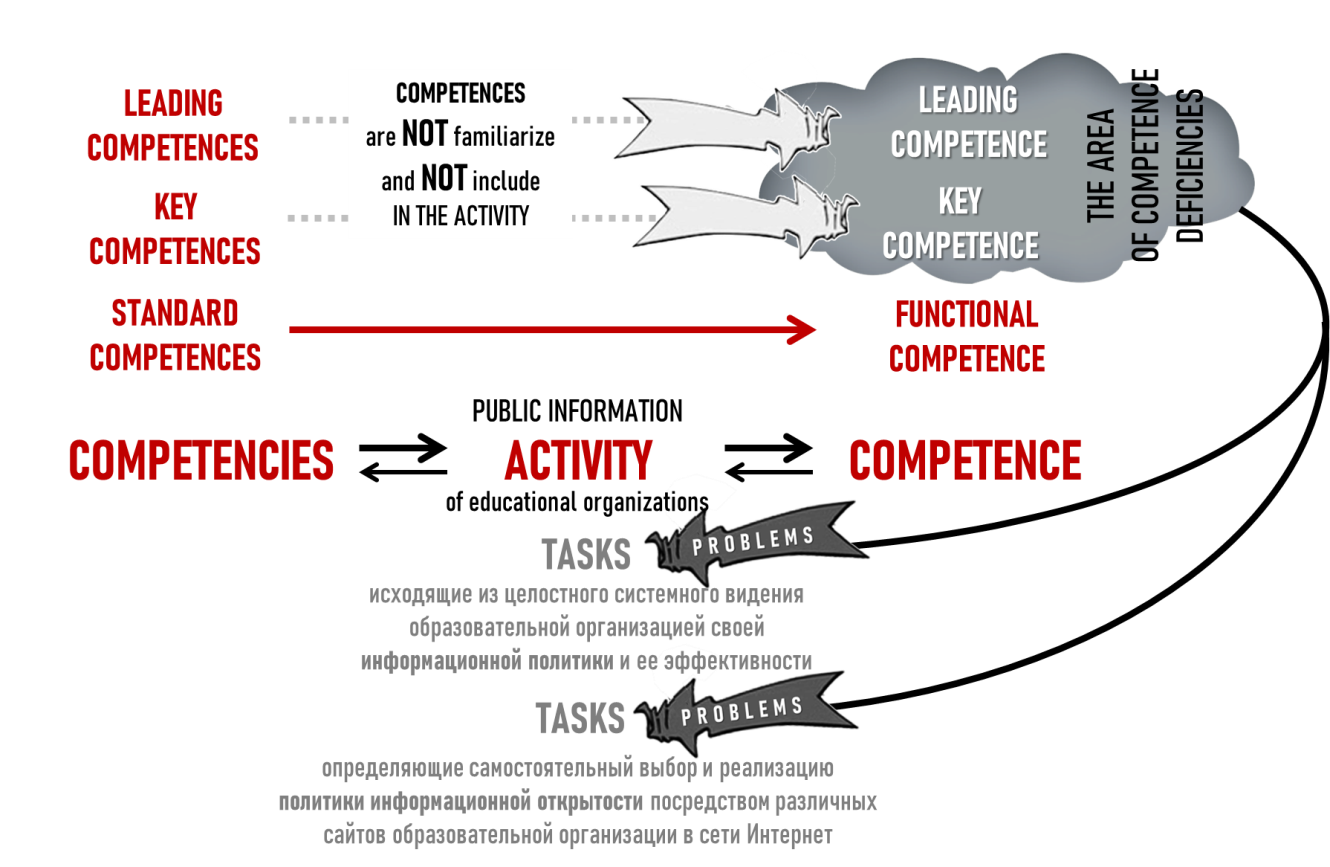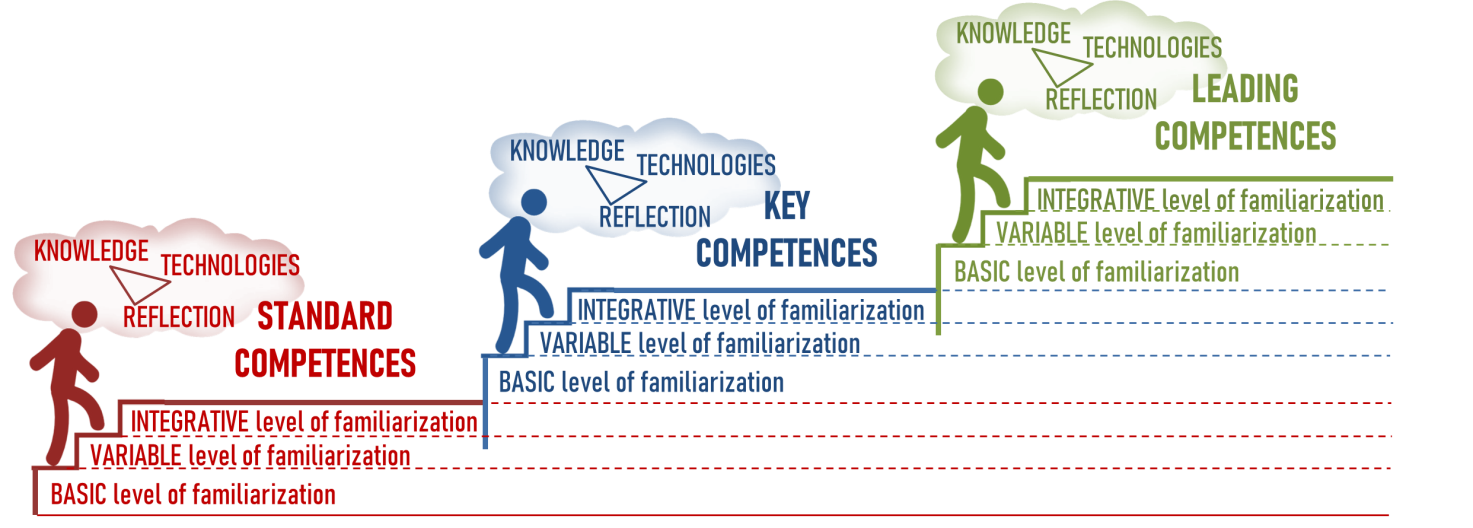Abstract
For the successful solution of socially significant problems of information openness of educational institutions we need to overcome the problems associated with the incompetence of the leaders and teachers of educational institutions in their new public information activities on the Internet. In relying on the methodological triad "competence - activities - competencies", according to which competencies are the sources of the task activity, and on the approach to the identification of the standard, the key and leading competences, the author offers competence level model of educational organizations in the implementation of the tasks of public information activities in the Internet. According to this model, the development of standard competencies allows us to solve problems related to the state requirements to the official site and to develop this mandatory for all educational organizations, public information resource in accordance with the social and professional needs of public information about the activities of educational institutions. The development of key competencies will significantly expand the horizons of information openness through the establishment and development of the personal websites of individual and collective stakeholders, thematic websites on various activities united in the information portal of the educational organization. Development of leading competence will contribute to the successful solution of problems of designing and implementing information policy educational organization, forming the image of a competent public educational organization through representation on the internet achievements and problems that it solves in the implementation of its educational policy.
Keywords: Educational organizationinformation opennessinformation policy
Introduction
The success in dealing with a specific area of information openness of the tasks that are associated with the creation of the official websites of educational institutions across the country, linked to sufficiently clear positioning of competences in the field of problems of public information activities of the educational organization (Federal law FZ-273 of 29.12.2012).
However, as it has been repeatedly mentioned (Asmolova & Ovchinnikova, 2019; Asmolova, 2019), the reduction of opportunities of information openness only to the conduct of the official site, and meet the requirements, limited only by the regulatory specified content (The order of Federal service for supervision of education and science of 29.05.2014 No. 785) leads to the fact that educational institutions present themselves on the Internet only through the official information about them.
Minimize this trend will the successful implementation of the tasks of information policy of educational institutions, aimed at increasing transparency, the development of public information resources on the Internet and the creation of a public image of the educational organization as a competent organization, to cope successfully with the challenges of time.
One of the most important conditions that will contribute to success in the implementation of information policy objectives is a clear definition of the competencies of the most educational organizations in the design and implementation of its information policy.
Problem Statement
Since public information work is new to the educational organization, the leaders and teachers of schools, kindergartens, children's supplementary education institutions are facing serious difficulties related to the definition of competences in this area of activity.
In fact, we are talking about an issue that reveals a discrepancy between the actual tasks of designing and implementing their own information policy aimed at increasing information transparency, the development of public information resources of educational organization on the Internet and the creation of a public image of the educational organization as the competent authority on the one hand. On the other hand, this is due to the reluctance of both ignorance and the lack of a clear understanding of the competencies within the range of tasks of information policy of the educational organization.
In accordance with the approach, suggested Plakhova (2008), competences are interrelated elements in the system triad of "competence-competence activities". This means that the problem highlighted the lack of clear understanding of the causes and deepens the competencies of participants incompetence problem of activity and leads to an inefficient solution of problems of public information activities in educational institutions (figure

Leading the way implementation of public information activities is to create a public information resources that can widely inform about educational organization and motivate the society to familiarizing in solving educational problems in the educational institution, district, region and country.
Based on this, one of the first areas in the field of solving the problems of information policy becomes design competencies, focusing heads and teachers of schools, kindergartens, children's supplementary education institutions in the development of public information resources, informing the society and the state of all socially important directions of its activity.
Research Questions
The main research question is the question of the development of competencies of the educational organization in the field of public information activities So educational institutions will not only comply with state requirements for information openness, but also to successfully carry out its information policy, aimed at meeting the growing social and professional needs of public information about the activities of educational institutions.
The hypothesis of the study is that highlighting the difficulty levels of the educational organizations of tasks aimed at the formation and development of public information resources, it is possible to design a tiered model of competences.
The development of the model participants in the public information activities will allow to develop its expertise in the field of new educational institutions for public information activities.
Purpose of the Study
Designing competence level model of public information activities, consistent with the objectives of information policy of educational institutions, aimed at the formation and development of public information resources of educational institutions on the Internet.
Research Methods
In the course of work used methods of theoretical research, systematization and classification, method of comparative research, approaches and methods for designing competencies.
Findings
The development of the model of competencies of educational organizations in public information activities was based on the approach proposed by Bazarov (2005) to identify organization competencies.
This approach is presented in the theory of organizational development as an area of development of competencies that organizations should master. At the same time, organizations strive to have advantages, develop their strengths and see the need not only to “keep up” with the times, but also to anticipate the need for organizational changes
Bazarov (2005) believes that management in each organization should have a clear idea of the three types of competencies of the organization and be able to identify them in accordance with the complexity levels of the tasks facing the organization. He refers to such types of competencies:
standard competencies (the ability of an organization to solve typical tasks for a given type of activity);
key competencies (the organization’s ability to solve tasks innovative for this type of activity);
leading competencies (organization's ability to create new types of professional activity).
Applying this typology to solving the research problem of designing the competencies of educational organizations in public information activities, it seems possible to identify the following problem areas and the types of competencies corresponding to them (figure

First of all, we are talking about standard competencies that correspond to tasks that can be represented as typical and binding in all educational organizations. This area of tasks is associated with the need to fulfill the functional requirements legally defined by the state in the competencies of the educational organization related to the maintenance of the official website.
The next type of competencies is the key competencies that correlate with the tasks of expanding information transparency beyond normative requirements by creating other types of sites of educational organizations. Thus, we are talking about the level of competencies, which become the "key" for independent decisions by educational organizations on issues of their chosen policy of information transparency and the policy of informing about different areas of activity of an educational organization.
At the highest level of competencies, which are defined as leading competencies, an educational organization is increasing its ability to solve the problems of understanding the information policy that it has chosen, develop its holistic systemic vision, include information culture issues in the information policy tasks, create a public information image through existing and developing potential public information resources. This area of tasks includes the ability of an educational organization to conduct a constructive social dialogue with society and the professional community in the design and implementation of its educational policy.
Moreover, these competencies fully confirm their name, since they “lead” the development of standard and key competencies, forcing participants in public information activities to update and improve standard and key competencies, taking into account more complex tasks of the educational organization’s information policy.
The identification of standard, key and leading competencies allows us to present an approach to understanding the levels of competence of leaders and teachers as the competencies shown by them in the practice of activity and their ability to solve problems of public information activity in an educational organization. Thus, we can identify:
- level of functional competence achieved as standard competencies shown in the activity and successful solution of functional tasks aimed at compliance with state requirements for the official website of the educational organization;
- the level of key competence achieved as key competencies manifested in the activities and the successful solution of the tasks of creating and developing various types of sites in an educational organization, including personal sites (sites of teachers, sites of children’s groups, sites of professional pedagogical associations and collegial and public administration bodies, etc. e.), thematic sites in various areas of activity, and the unification of all public information resources of educational organizations in the information portal. Thus, the level of achieved key competence is manifested in an effective solution to the information transparency policy independently chosen in the educational organization;
- the level of leading competence achieved as leading competencies manifested in the activities and successful solution of the tasks of designing and implementing the information policy of the educational organization, which, on the basis of broad information about its activities, helps to engage in a constructive social dialogue in the field of education, and thus creates a positive image of the educational organization as a competent organization.
In turn, the selection of functional, key and leading levels of competency allows us to form an idea of the area of competency deficits observed in the practice of educational organizations. Of course, a positive trend is observed in the development of standard competencies, which indicates the desire to eliminate competency deficits in the field of functional competence of managers and teachers responsible for maintaining the official website. However, it is precisely the insufficient development of the key and leading competencies of the educational organization in public information activity that becomes the source of problems in solving the problems of expanding information openness and shaping the information policy of educational organizations (figure

In order for leaders and teachers of educational organizations to master and demonstrate standard, key and leading competencies in their activities, it is not enough just to identify them in public information activities. It is necessary that these competencies present a clear course of action for participants in implementing the tasks of information transparency and the information policy of an educational organization.
The formation of such a course of action is associated with the need to develop an indicative framework for action. In the psychological theory of the phased formation of mental actions developed by Galperin (1998), the approximate basis of action is a system of representations of a person about his goal, plan, methods and means of implementing action.
The design of an indicative basis for actions in the development of standard, key and leading competencies in the public informational activities of educational organizations should be related to the question of what level of development of ways of activity is represented by the ability to be included in solving activity tasks: by the reproductive level (ability to act on a given pattern); by the reconstructive level (the ability to incorporate and apply new elements in the practice patterns used) and by the creative level (the ability to create new)
This approach made it possible to identify in each of the areas of standard, key and leading competencies in the public information activities of educational organizations the corresponding levels of their development, including:
- basic level as required for the development of this area of competence and using methods of action on the model;
- variable level, representing the freedom of choice of methods of action by subjects of activity within the framework of these competencies and to apply various methods of action available in practice;
- integrative level, ensuring the achievement of the integration of a variety of basic and varied methods of action and developing the ability to create new activities in their practice (figure

Thus, the identification of standard competencies by the level of complication of tasks aimed at ensuring the functioning and development of the official website of an educational organization allows us to select:
- basic competencies, the implementation of which is related to compliance with the requirements set for educational organizations on the structure, content and information security of official sites;
- variable competencies, in the process of implementation of which educational organizations independently design variable components of the official site structure and select the content of additional (in excess of specified standards) information about their activities;
- integrative competencies, the development of which will allow the educational organization to use effective information technologies that ensure the automatic integration of information content elements in the structure of the official website and integrate information with various automated management systems at the federal, regional and municipal levels.
The identification of key competencies aimed at creating and developing various public information resources on the Internet, through which the horizons of information openness of educational organizations expand, according to the level of complexity of tasks includes the following competencies:
- basic competencies, the implementation of which is associated with the implementation of recommendations of certification commissions on the publication of information on the professional activities of teachers on their personal information resources;
- varied competencies, during the implementation of which educational institutions create varied information resources on the Internet, including individual and collective personal sites and thematic sites by type of activity of the educational organization;
- integrative competencies, in the process of implementation of which an information portal of the educational organization is created, combining the information space of the educational organization on the Internet with a single entry point, where all public information resources created in the educational organization are represented.
The identification of leading competencies by the level of complexity of the tasks of designing and implementing an information policy as a “megaphone” of the educational policy of an educational organization represents the following competencies:
- basic competencies, the implementation of which is associated with the implementation of scientific and methodological recommendations for the design and implementation of the editorial policy of the information portal of an educational organization as an integrated and purposefully developing information resource, which is a means of public informing and a resource for generating public opinion on the activities of an educational organization;
- variable competencies, the development of which is associated with independent design of the concept, tasks and ways of implementing the information policy of the educational organization, forming a resource of social and professional trust in it as a collective subject of the implementation of state policy in the field of education and educational policy;
- integrative competencies, in the process of mastering which information-motivational conditions for integration and interactive interaction of participants in a constructive social dialogue are created in the process of reframing (new understanding) of the prospects for the development of an educational organization, its educational and information policy taking into account changing social needs.
Further development of the presented level model of the competencies of the educational organization in public information activity is associated with the formation of its three components: cognitive, technological and reflective (figure

The cognitive component of mastering competencies includes the knowledge necessary for mastering competencies, and understanding the indicative basis of actions that must be mastered in the process of mastering competency.
The technological component determines the mastery of practical ways to implement competency, which is especially important when teachers master the practice of building sites and rapidly developing information and communication technologies on the Internet.
The reflective component is a necessary component of the development of competencies, since it is associated with the self-assessment by the subjects of activity of the results of achievements in a new public information activity.
The development of this component is based on the model of Schon (1990), which presents practical reflection as the ability of a professional to integrate his own experience, available theoretical knowledge and a research approach to find the optimal solution to ambiguous practical problems. It should be noted that the need to include a constructive element of reflective practice not only contributes to the formation of “reflexive knowledge” (Shchedrovitsky, 2005), but also ensures the integrity of the formation of a competent action, the basis of which is knowledge, actions and reflection.
Conclusion
The presented level model of competencies in public information activity is one of the answers to the problems associated with the lack of competence of heads and teachers in the new public information activity for educational organizations.
This model allows us to determine the level of relevant competence of participants in public information activities in the development and application in practice of standard, key and leading competencies.
Using this model, educational organizations as collective stakeholders can build their educational route in developing the necessary competencies and achieving the level of competence they potentially need in solving the problems of expanding information openness and designing an information policy aimed at meeting growing social and professional needs for open information about the activity of education organizations.
Acknowledgments
Research carried out in the research work of the Federal Institute of Education Development RANEPA "11.18. Methods for assessing the quality of public information resources of educational institutions", commissioned by the Russian Presidential Academy of National Economy and Public Administration on 2020.
References
- Asmolova, A. M., & Ovchinnikova, N. R. (2019). From information openness to information policy of educational organizations. The European Proceedings of Social and Behavioural Sciences, LXIV, 55-63. https://doi.org/10.15405/epsbs.2019.07.7
- Asmolova, L. M. (2019). Methodological aspects of the information policy in the educational organizations. The European Proceedings of Social and Behavioural Sciences, LXIV, 46-54. https://doi.org/10.15405/epsbs.2019.07.8
- Bazarov, T. U. (2005). Strategicheskiy assesment v perspektive organizacionnih izmeneniy [Strategic assessment in the perspective of organizational changes]. Yearbook of the Russian psychological society, 3, 91-93. https://istina.msu.ru/publications/article/1052730/
- Galperin, P. Y. (1998). Psihologiya mishleniya i ucheniye o poetapnom formirovanii umstvennih deystviy [Psychology of thinking and the doctrine of gradual formation of mental actions]. In P.Y. Galperin (Ed.), Psychology as an objective science (рр. 236—277). http://psychlib.ru/inc/absid.php?absid=107896
- Plakhova, L. M. (2008). Kurs molodogo boyca, ili Azbuka direktora shkoli: prakticheskoye posobiye [The Young Soldier Course, or Principal's ABC: A Practical Manual]. Moscow.
- Schon, D. F. (1990). The Reflective Practitioner: How Professionals Think in Action. https://www.amazon.com
- Shchedrovitsky, G. P. (2005). Refleksiya v deyatelnosti [Reflection in activity]. In G.P. Shchedrovitsky (Ed.), Thinking--Understanding--Reflection (pp. 64-125). Moscow, Russia.
Copyright information

This work is licensed under a Creative Commons Attribution-NonCommercial-NoDerivatives 4.0 International License.
About this article
Publication Date
15 November 2020
Article Doi
eBook ISBN
978-1-80296-093-8
Publisher
European Publisher
Volume
94
Print ISBN (optional)
-
Edition Number
1st Edition
Pages
1-890
Subjects
Psychology, personality, virtual, personality psychology, identity, virtual identity, digital space
Cite this article as:
Asmolova, L. M. (2020). The Competence Of An Educational Organization In Implementing Public Information Activities. In T. Martsinkovskaya, & V. Orestova (Eds.), Psychology of Personality: Real and Virtual Context, vol 94. European Proceedings of Social and Behavioural Sciences (pp. 45-54). European Publisher. https://doi.org/10.15405/epsbs.2020.11.02.6

